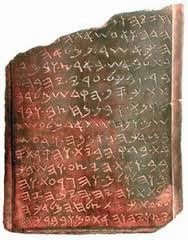Shekalim 19
Cleaning House
מלכים ב יב: י וַיִּקַּח
יְהוֹיָדָע הַכֹּהֵן אֲרוֹן אֶחָד וַיִּקֹּב חֹר בְּדַלְתּוֹ וַיִּתֵּן אֹתוֹ
אֵצֶל הַמִּזְבֵּחַ בימין (מִיָּמִין) בְּבוֹא-אִישׁ בֵּית יְהוָה
וְנָתְנוּ-שָׁמָּה הַכֹּהֲנִים שֹׁמְרֵי הַסַּף אֶת-כָּל-הַכֶּסֶף הַמּוּבָא
בֵית-יְהוָה
When
the box was full, they would
empty it out and use it to pay the craftsmen who did repairs in the Temple .
Yehoash ruled in
the ninth century BCE, he was a contemporary of the prophet Elisha.
Archaeological artifacts from that time period in Israel are few and far between.
Therefore when antiquities collector Oded Golan announced ten years ago that he
had bought an inscription that was written by Yehoash and talks about donations
for repairs to the Temple ,
there was hoge excitement. Not only a mention of an early king of Judah but an
artifact that substantiates a story in Tanakh! Here is the inscription:
The text goes like
this (thanks Wikipedia)
|
[אנכי
· יהואש · בן · א]
חזיהו
. מ[
הדה . ואעש . את . הב[...] ה . כאשר . נמלאה . נד בת . לב אש . בארץ . ובמד בר . ובכל . ערי . יהדה . ל תת · כסף · הקדשם · לרב · לקנת · אבן · מחצב · ובר שם . ונחשת . אדמ . לעשת . במלאכה . באמנה . ואעש את . בדק . הבית . והקרת ס בב . ואת . היצע . והשבכ ם . והלולם . והגרעת . וה דלתת . והיה . הים . הזה לעדת . כי . תצלח . המלאכה
יצו . יהוה . את . עמו . בברכה
|
[I am Yeho'ash, son of
A]hazyahu, k[ing over Ju]dah,
and I executed the re[pai]rs. When men's hearts became replete with generosity in the (densely populated) land and in the (sparsely populated) steppe, and in all the cities of Judah, to donate money for the sacred contributions abundantly, in order to purchase quarry stone and juniper wood and Edomite copper / copper from (the city of) ‘Adam, (and) in order to perform the work faithfully (= without corruption),— (Then) I renovated the breach(es) of the Temple and of the surrounding walls, and the storied structure, and the meshwork, and the winding stairs, and the recesses, and the doors. May (this inscribed stone) become this day a witness that the work has succeeded, (and) may God (thus) ordain His people with a blessing. |
Great, right? Not
so fast. Oded Golan is know as the dealer who brought other sensational finds
to light, among them the “James brother of Jesus” ossuary and the Israel
Antiquities Authority views him with some suspicion. They brought in experts in
ancient writing, in geology, in patina and anything else you might want. After
seven years of investigation, the court ruled . . . inconclusive. No proof it
was forged but no proof it was real either. The newest bizarre twist in the
story is that the Antiquities Authority wants the inscription, even though they
don’t think it is authentic. However, the Supreme Court ruled that it had to be
returned to Golan.




Comments
Post a Comment